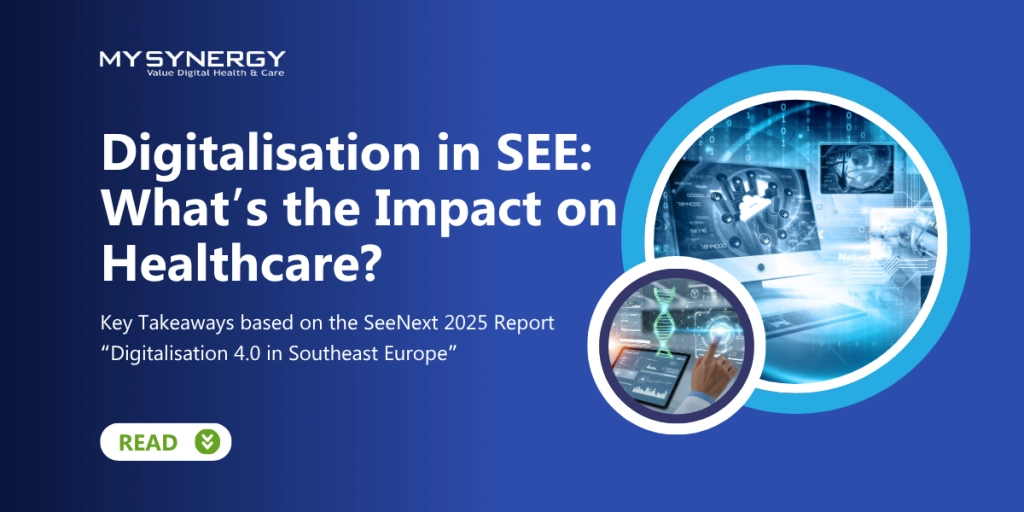Digitalisation in Southeast Europe: What’s the Impact on Healthcare?
The new SeeNext report, “Digitalisation in Southeast Europe 2025,” offers a comprehensive look at how Bulgaria, Romania, and Serbia are progressing on their digital journeys. At MY Synergy, we are driving digital transformation across healthcare, pharma, and beyond. As a Microsoft Technology Partner and a leader in health-tech innovation, we believe that understanding the digital landscape of Southeast Europe is crucial for shaping the future of our region. That’s why we’re sharing our insights on what these findings mean specifically for the healthcare industry, highlighting both the opportunities and the challenges that digital transformation brings to healthcare providers, patients, and innovators in our region.
Bulgaria shines in infrastructure and public digital services for businesses, but struggles with deeper adoption across small and medium-sized enterprises. Romania, on the other hand, enjoys one of the best broadband networks in Europe yet continues to battle low levels of basic digital skills among its population. Serbia stands out for combining skilled talent with high adoption of digital tools in the private sector, but lags behind in innovation and scale-up capacity.
For healthcare systems, these differences have very tangible implications. The region’s progress in digital public services and its expanding ICT sectors are strong foundations for connected healthcare, telemedicine, and data-driven innovation. However, uneven skill levels, limited AI integration, and gaps in automation mean that digital health solutions still face barriers to large-scale implementation.
Electronic health records, cloud-based hospital management, and AI-assisted diagnostics are no longer experimental technologies; they are becoming the foundation for patient-centered care. But to realise their full potential, digitalisation in healthcare must go beyond infrastructure. It requires interoperability, trust, and education.
As the report highlights, the region’s digitalisation remains “deep but narrow”: there are world-class ICT clusters and digital leaders, but adoption across entire industries, including healthcare, is uneven. This presents both a challenge and an opportunity. By aligning health institutions with the broader digital agenda, Southeast Europe can bridge that gap, creating an integrated health-tech ecosystem where data flows securely and decisions are evidence-based.
For hospitals and healthcare providers, investing in workforce digital skills is as crucial as investing in new software or equipment. AI, automation, and cloud solutions can only succeed if the people using them understand how to extract value from data responsibly.
This is where collaboration becomes vital between business, government, and academia, as the report recommends. Joint training initiatives, innovation hubs, and healthcare-focused digital academies could transform this human capital challenge into a regional strength.
Innovation ecosystems remain underdeveloped, with limited venture capital and few large-scale health-tech start-ups. If Bulgaria, Romania, and Serbia are to lead the next wave of healthcare transformation, they need to create environments where innovation can thrive, supported by clear regulation, access to financing, and cross-border partnerships.
From AI-driven diagnostics to predictive analytics and patient portals, the region has the potential to leapfrog legacy systems. But success will depend on long-term policy consistency and collaboration between the public and private sectors.
Digital leaders don’t simply adopt tools. They build connected, trust-based ecosystems that make technology meaningful for patients and providers alike. In the context of Southeast Europe, that leadership means:
Curious to dive deeper?
You can read the full SeeNext report here: Digitalisation 4.0 in Southeast Europe | 2025 edition | SeeNext
What the Data Tells Us and Why It Matters for Healthcare
The SeeNext 2025 report portrays a region that is digitally ambitious yet still fragmented in its execution. Serbia leads the way with strong human capital and widespread business digitalisation, while Bulgaria and Romania follow closely, each with its own unique mix of strengths and gaps.Bulgaria shines in infrastructure and public digital services for businesses, but struggles with deeper adoption across small and medium-sized enterprises. Romania, on the other hand, enjoys one of the best broadband networks in Europe yet continues to battle low levels of basic digital skills among its population. Serbia stands out for combining skilled talent with high adoption of digital tools in the private sector, but lags behind in innovation and scale-up capacity.
For healthcare systems, these differences have very tangible implications. The region’s progress in digital public services and its expanding ICT sectors are strong foundations for connected healthcare, telemedicine, and data-driven innovation. However, uneven skill levels, limited AI integration, and gaps in automation mean that digital health solutions still face barriers to large-scale implementation.
The Opportunity: Building a Digitally Enabled Health Ecosystem
Healthcare is one of the sectors that can benefit most from Southeast Europe’s digital acceleration. The infrastructure and human capital investments already underway, particularly in Bulgaria and Serbia, can directly support the transition toward smarter, data-powered healthcare systems.Electronic health records, cloud-based hospital management, and AI-assisted diagnostics are no longer experimental technologies; they are becoming the foundation for patient-centered care. But to realise their full potential, digitalisation in healthcare must go beyond infrastructure. It requires interoperability, trust, and education.
As the report highlights, the region’s digitalisation remains “deep but narrow”: there are world-class ICT clusters and digital leaders, but adoption across entire industries, including healthcare, is uneven. This presents both a challenge and an opportunity. By aligning health institutions with the broader digital agenda, Southeast Europe can bridge that gap, creating an integrated health-tech ecosystem where data flows securely and decisions are evidence-based.
Human Capital: The Missing Link in Health Transformation
One of the report’s key findings is that even the most digitally advanced economies in the region face shortages in practical digital skills. In healthcare, this skill gap is even more pronounced. Clinicians, administrators, and decision-makers often lack the data literacy or digital training needed to make full use of new tools.For hospitals and healthcare providers, investing in workforce digital skills is as crucial as investing in new software or equipment. AI, automation, and cloud solutions can only succeed if the people using them understand how to extract value from data responsibly.
This is where collaboration becomes vital between business, government, and academia, as the report recommends. Joint training initiatives, innovation hubs, and healthcare-focused digital academies could transform this human capital challenge into a regional strength.
Innovation Needs Infrastructure and Vision
The healthcare sector’s digital future depends on two enablers: infrastructure and innovation. Southeast Europe’s robust ICT industries and growing connectivity offer a foundation for building secure data platforms and interoperable health systems. But as the report points out, infrastructure alone is not enough.Innovation ecosystems remain underdeveloped, with limited venture capital and few large-scale health-tech start-ups. If Bulgaria, Romania, and Serbia are to lead the next wave of healthcare transformation, they need to create environments where innovation can thrive, supported by clear regulation, access to financing, and cross-border partnerships.
From AI-driven diagnostics to predictive analytics and patient portals, the region has the potential to leapfrog legacy systems. But success will depend on long-term policy consistency and collaboration between the public and private sectors.
A Path Forward
Digitalisation is not just about technology. It’s about improving lives. For Southeast Europe’s healthcare sector, that means moving from pilot projects to sustainable systems that enhance patient outcomes, reduce administrative burden, and enable smarter use of resources.Digital leaders don’t simply adopt tools. They build connected, trust-based ecosystems that make technology meaningful for patients and providers alike. In the context of Southeast Europe, that leadership means:
- Aligning with EU standards for data protection, interoperability, and cybersecurity to ensure healthcare systems can exchange data safely and effectively.
- Investing in AI-driven care experiences - from predictive analytics that support clinical decisions to digital assistants that improve patient engagement.
- Fostering organizational readiness by empowering healthcare leaders and teams to manage change, not just technology.
- Collaborating across business, government, and academia to co-create sustainable, patient-centered solutions that deliver measurable health and economic benefits.
About MY Synergy
As a trusted partner in digital transformation, MY Synergy combines deep healthcare expertise with advanced analytics, automation, and cloud-native technologies. We empower healthcare clients to innovate securely and at scale, co-creating solutions that anticipate tomorrow’s challenges. Our commitment to quality, compliance, and measurable outcomes sets us apart as a catalyst for digital progress in Southeast Europe and beyond.Curious to dive deeper?
You can read the full SeeNext report here: Digitalisation 4.0 in Southeast Europe | 2025 edition | SeeNext





